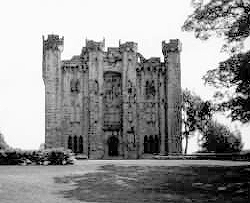Until the 18th century, the two halves of Sunderland were only linked by ferries. Today, the river is crossed by three bridges, the A19 bridge, the large arched Wearmouth Bridge which was constructed in 1929 and the Queen Alexandra Bridge of 1909.
Hylton Castle, which is one of Sunderland’s oldest buildings, stood guard over one important Wear ferry crossing. The man responsible for its construction was William Hylton who erected the castle in around the year 1400. It is most famous for a ghost who goes by the name of the ‘Cauld Lad of Hylton’. The Cauld Lad is said to be the spirit of a stable hand who was murdered by a Hylton Baron in the 16thcentury. The stable boy was apparently caught sleeping on the job by the baron, who in a fit of temper, struck him with a pitchfork and killed him instantly.

Hylton Castle Today
The Cauld Lad, who it is rumoured, carried his head under his arm, was often seen or heard by the staff at Hylton Castle. Apparently, his favourite trick was throwing crockery, but curiously, this would only happen if the kitchens had been left in a tidy condition. Even more curiously, if the kitchens were left in a messy condition, he would tidy up! Perhaps not surprisingly, the kitchen staff would endeavour to leave the area in a mess. Occasionally, the ghost would take his activities further afield and sail the Hylton ferry himself, by impersonating the boatman, he would accept payment then leave his passengers stranded in the middle of the river.
The actions of the Cauld Lad were finally put to an end when he was given a green cloak and hood by the Hylton servants. They lay the garments in front of the Kitchen fire and waited until midnight at which time, the ghost appeared, took the items and disappeared after uttering his last words: “Here’s a cloak and here’s a hood, the Cauld Lad o’ Hylton will do no more good”.
Castle was occupied until early in the 20thcentury and all that remains today is a ruined shell that can be found, sensibly enough, in the Hylton Castle district of Sunderland. Some notable features, which remain of the ruins, are the coats of arms carved in stone on the walls. Included are the shields of the Eures, Greys, Percys, Lumleys, Hyltons and the Washingtons. The stars and bars of the Washington family coat of arms are believed to have been taken up by one member of the family in particular, a certain George Washington who adapated the design for the flag of the United States!
